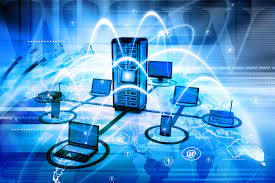The Internet is the world’s largest computer network. Let’s break that down A computer network is any group of interconnected computing devices capable of sending or receiving data. A computing device isn’t just a computer—it’s any device that can run a program, such as a tablet, phone, or smart sensor.
Building a network
The simplest computer network is two devices:
A network like that only has to worry about a few things, like how to physically connect the two devices and how to send data over the physical connection in a format they both understand.
Let’s add one more device:
Now there’s additional complexity. How can each device know whether incoming data is meant for them or for their neighbor? This simple network will need an addressing scheme.
Let’s jump to six devices. There are actually many ways we can connect six devices together in a computer network:
Each of those arrangements is a different network topology, and each topology has its advantages and disadvantages.
Imagine the journey of a piece of data through one of those larger networks. What path will it take? When there are multiple paths, how does it know which path is best?
Once networks become larger, routing strategies become more important. There isn’t a big difference between two stops and three stops in a path, but there is a big difference between 20 stops and 300 stops.
Types of networks
We use different terms to refer to networks based on their size and characteristics. Let’s touch on a few of them here.
The most common type of network is the Local area network (LAN), a network that covers a limited area like a house or school.
The largest type of network is a Wide Area Network (WAN), a network that extends over a large geographic area and is composed of many, many LANs. Oftentimes, the networks in a WAN can only be connected by leasing telecommunications lines from different companies, since no single company owns all the infrastructure across the wide geographic area.
Another type of network is the Data Center Network (DCN), a network used in data centers where data must be exchanged with very little delay.
Networking protocols
Whenever computing devices are connected together in a network, they need protocols to communicate with each other.
If the devices want to communicate over the Internet, they must use the Internet networking protocols. There are many networks that aren’t connected to the Internet that also use the Internet protocols, due to how well designed they are for networking.
However, there are networks that use other protocols that are more suited for their task. Data center networks often opt to use networking protocols that take advantage of the incredibly closely knit architecture of the data center. That enables data centers to more efficiently run intensive algorithms, such as training a deep learning network.
As we go forward in this unit, we will focus specifically on the Internet protocols that power the majority of computer networks. In the future, networks might be using protocols that haven’t even been invented yet. Fortunately, the concepts underlying the Internet protocols are relevant to all networked systems.
![]()
If you would like liquidvideotechnologies.com to discuss developing your Home Security System, Networking, Access Control, Fire, IT consultant, or PCI Compliance, please do not hesitate to call us at 864-859-9848 or you can email us at deveren@liquidvideotechnologies.com.
Article Provided By: Kahnacademy







Recent Comments